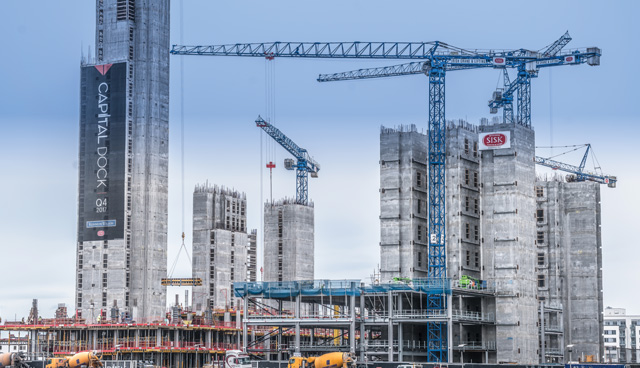
Apprenticeship crisis within the construction industry
1st August 2018
It’s a policy that benefits the few over the many
1st August 2018Part V overview

As construction gathers pace, developers must be cognisant of their obligations under Part V.
Part V of the Planning and Development Act 2000 is a mechanism established by government which dictates that local authorities can obtain up to 10 per cent of land zoned for housing development at “existing use value” rather than at “development value”. It is intended to facilitate the delivery of social and affordable housing. The decision on what percentage of a development site must be reserved for social housing is at the discretion of the local authority. Before the 2015 Act, up to 20 per cent of zoned land could be acquired, but was reduced firstly, to account for the change in the economic picture and secondly, to encourage more construction through a reduction in cost to developers.
The stated objective of Part V is to “ensure an adequate supply of housing for all sectors of the existing and future population”. When submitting a planning application for a development of more than nine houses, or on a site which exceeds 0.1 hectares, developers must undertake Part V obligations.
The Urban Regeneration and Housing Act 2015 made several amendments to Part V to facilitate greater availability of social housing and ensure greater transparency in the process. Until the change in September 2015, developments of four or less properties were exempt from Part V.
If planning permission was granted without a Part V agreement prior to 1 September 2015, the developer must retrospectively comply the requirements of the 2015 Act. If a Part V agreement was reached and no commencement notice has been lodged, it may be renegotiated with the consent of both the developer and the local authority.
A Part V agreement is an agreement between a developer and the planning authority which outlines the conditions by which the developer will meet their obligations. As such, when submitting a planning application, developers must specify how they intend to comply with these obligations.
It is no longer possible for developers to fulfil Part V obligations through financial payment, making available serviced sites on the development or by transferring undeveloped land outside the application area. Instead, the options for compliance include:
• Section 96(3)(a): transfer of land, the default option for the developer (which must be accepted by the local authority); and
• Section 96(3)(b): building and transfer of houses on-site; transfer of houses on land off-site within the function area; grant of a lease of houses on or off-site within the function area; or a combination of two or more of the options under section 96(3)(b).
If an alternative option is submitted under 96(3)(b), it is incumbent on the local authority to ensure it attains an equivalent planning return. The compensation payments made by the local authority is proportionate to the “existing use value” as per the date that planning permission is granted.
Planning applications must now incorporate developers’ proposals for complying Part V and it is now compulsory that a Part V agreement is reached between developers and local authorities before a commencement notice is issued. The proposal is not required to be overly detailed but must outline:
• how the applicant intends to discharge their obligation as regards a selection of a preferred option from the options available under the Act;
• details in relation to the units or land to be provided; and
• indicative costs.
Consideration of Part V issues should commence at the earliest point possible.
This helps to ensure that developers understand their obligations when designing developments. Prior to the submission of a planning application, it is recommended that developers meet with planning and housing staff to ensure that Part V option is agreed meets the objectives of the respective housing strategy. The Department of Housing, Planning, Community and Local Government guidelines indicate: “Consideration of Part V issues should commence at the earliest point possible.”
Overall, the local authority retains a considerable degree of discretion with regards to the manner in which developers’ obligations are executed. Therefore, it is important for developers to understand and adhere to these social housing requirements at an early stage in order to avoid subsequent delay.
The housing department within a local authority has an enhanced role. Upon the receipt of a pre-planning proposal, planning departments are now required to notify their housing department counterparts in order to assess the proposal’s conduciveness to housing strategy.
When considering the proposal, under Section 96(3)(c), the planning authority is required to have regard to its housing strategy and other matters. This ensures that the housing and planning departments within local authorities conclude a shared vision in relation to Part V units on the site, with reference to the housing strategy. This takes account of:
• the existing need and likely future need of social housing;
• the need to ensure that housing is available for persons who have different levels of income;
• the need to ensure that a mixture of house types and sizes is developed to reasonably match the requirements of the different categories of households, as may be determined by the local authority; and
• the need to counteract undue segregation in housing between persons of different social background.
The housing department can then contact the developer, extend an invitation for preliminary discussions in relation to Part V (which the developer is not obliged to attend) and provide recommendations for design stage. If the local authority intends to use an AHB to deliver Part V, it is also possible for the developer to express a view in relation to a potential partner AHB, but ultimately the choice lies with the local authority.
There are several categories of development which are exempt from Part V:
• if the development consists of nine houses or less;
• the housing is on land of 0.1 hectares or less;
• provision of houses by an approved body for social housing and/or affordable housing;
• the conversion of an existing building or the reconstruction of a building to create one or more dwellings (provided that at least 50 per cent of the external fabric is retained);
• carrying out works to an existing house; and
• development of houses under a Part V agreement.
Under section 97, the first two categories require an Exemption Certificate which can be obtained through application to the planning authority, prior to submitting a planning application.




